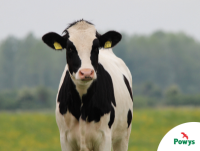Bluetongue virus confirmed in Powys - livestock keepers urged to stay vigilant

6 October 2025

The cases, two near Llangammarch Wells and the other near Gladestry, are each related to a single bovine animal that has tested positive for Bluetongue virus. All three premises have had movement restrictions imposed and currently no further control zones have been put in place within Powys.
Last week (1 October), the Welsh Government implemented a new Bluetongue Virus Temporary Control Zone in Monmouthshire following another confirmed case of Bluetongue virus on a farm near Chepstow.
Now Powys County Council's Animal Health Team are urging livestock keepers to remain vigilant and report any suspected cases. Bluetongue is a notifiable animal disease and, if suspected, livestock keepers must report it immediately to the Animal and Plant Health Agency (APHA) on 0300 303 8268.
Bluetongue is caused by a virus that is primarily transmitted by certain species of biting midges. It affects ruminants (such as cattle, goats, sheep and deer) and camelids (such as alpacas and llamas).
There are many strains of bluetongue. Cases of serotype 3 (BTV-3) were identified in England in November 2023 and the virus can also be spread through germinal products (semen, ova, and embryos) as well as transmitted maternally from mother to unborn offspring.
Clinical signs when present, can include: fever, crusting and ulcers around the muzzle area, swollen head, salivating and lameness. You may also see other signs including reduced milk yield, abortions and malaise.
Bluetongue does not affect people or food safety.
The main control measures for Bluetongue are the implementation of control zones and movement restrictions of susceptible species within these zones.
However, livestock owners should follow this advice to control the spread of Bluetongue
- Keepers of ruminants and camelids can help minimise potential spread of bluetongue by checking the health of your animals and reporting any suspicious clinical signs
- All livestock must be registered with the Rural Payments Wales (RPW) and the Animal and Plant Health Agency (APHA). You can do this online at http://gov.wales/get-county-parish-holding-cph-number
- You must register all land and buildings used to keep livestock, even short term lets, so the location of susceptible animals can be traced to help prevent and control disease.
- Animals on a bluetongue restricted premises and animals in certain disease control zones can only move with an appropriate licence
- The Animal and Plant Health Agency (APHA) carries out surveillance to check for disease. This may include blood sampling on holdings with susceptible animals in high-risk areas and in disease control zones.
Three BTV-3 vaccines are available for use in England, Scotland and Wales, subject to licence. Two of these have been granted UK marketing authorisation by the Veterinary Medicines Directorate. Farmers are urged to consider vaccination of their susceptible livestock.
Cllr Richard Church - Cabinet Member for Legal and Regulatory Services, said: "The confirmation of Bluetongue cases in Powys is a serious concern, and we urge all livestock keepers to remain vigilant.
"Early detection and swift reporting are vital to help contain the spread of this disease and protect animal health across the county.
"Our Animal Health Team is working closely with partners to monitor the situation, and we encourage farmers to familiarise themselves with the symptoms and take appropriate preventative measures, including considering vaccination.
"Together, we can help safeguard Powys' farming communities and livestock."
Further guidance on bluetongue can be found on the Welsh Government website: https://www.gov.wales/animal-health




